Reflection on a Nursing Incident: Manual Handling Challenges
VerifiedAdded on 2023/06/05
|7
|1784
|250
Journal and Reflective Writing
AI Summary
This assignment is a reflective journal entry from a nursing student detailing a negative experience during a clinical placement involving manual handling of a patient. The student describes the incident, which involved attempting to assist an elderly, obese patient with mobility issues, resulting in a fall and injuries to both the patient and the student. The reflection explores the student's feelings of shock, guilt, and inadequacy, highlighting the impact on their self-esteem and understanding of their skill gaps. The evaluation section discusses the negative consequences of ineffective manual handling for both patients and nurses, emphasizing the importance of risk assessment and effective communication. The analysis delves into the bioethical principle of non-maleficence and the student's failure to apply safe patient handling practices. The conclusion outlines the student's commitment to improving their skills through training, mentorship, and evidence-based learning. The action plan includes seeking guidance from a mentor, attending workshops, and studying relevant literature to enhance their knowledge and confidence in manual handling techniques. The assignment also includes a list of references supporting the student's reflection on the importance of safe patient handling and its impact on patient care.
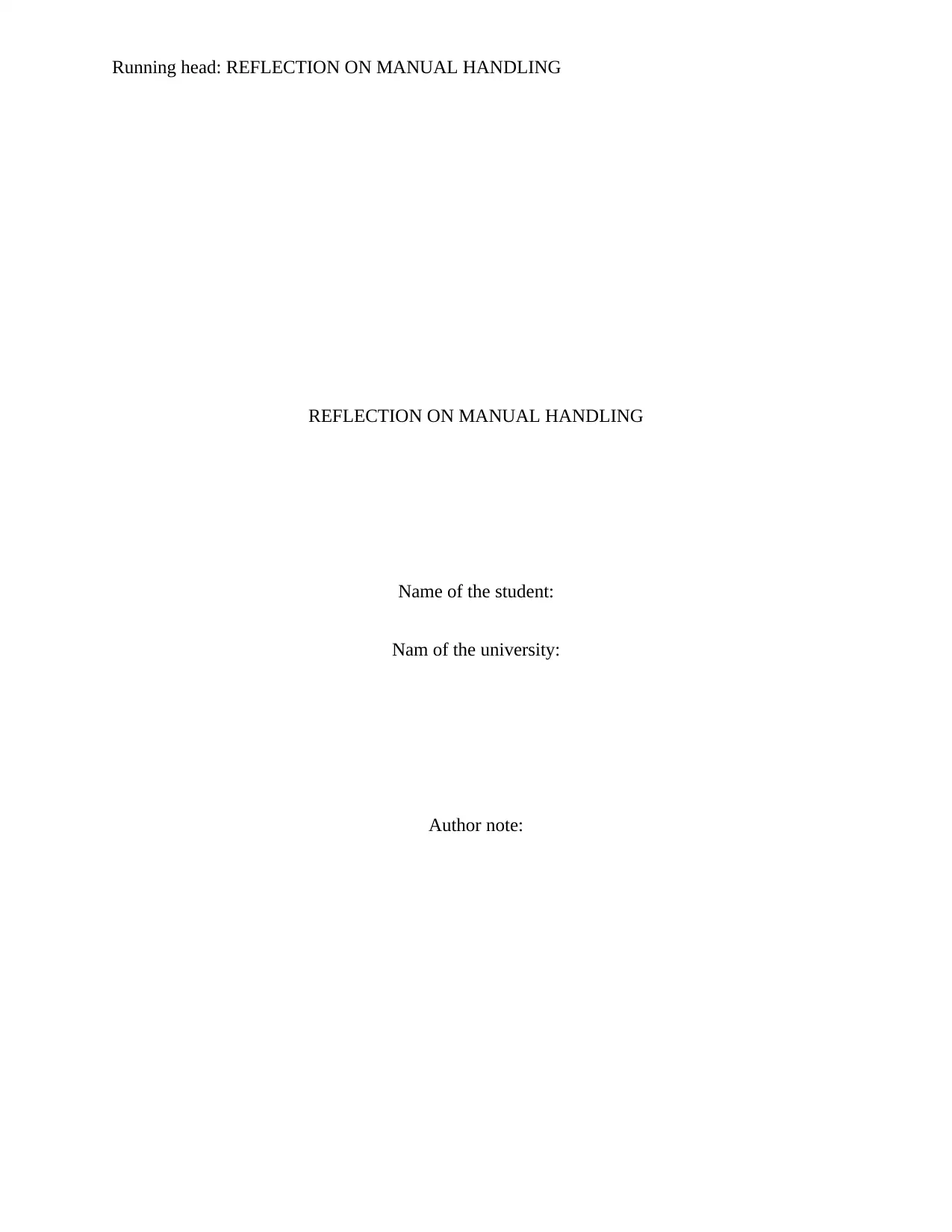
Running head: REFLECTION ON MANUAL HANDLING
REFLECTION ON MANUAL HANDLING
Name of the student:
Nam of the university:
Author note:
REFLECTION ON MANUAL HANDLING
Name of the student:
Nam of the university:
Author note:
Paraphrase This Document
Need a fresh take? Get an instant paraphrase of this document with our AI Paraphraser
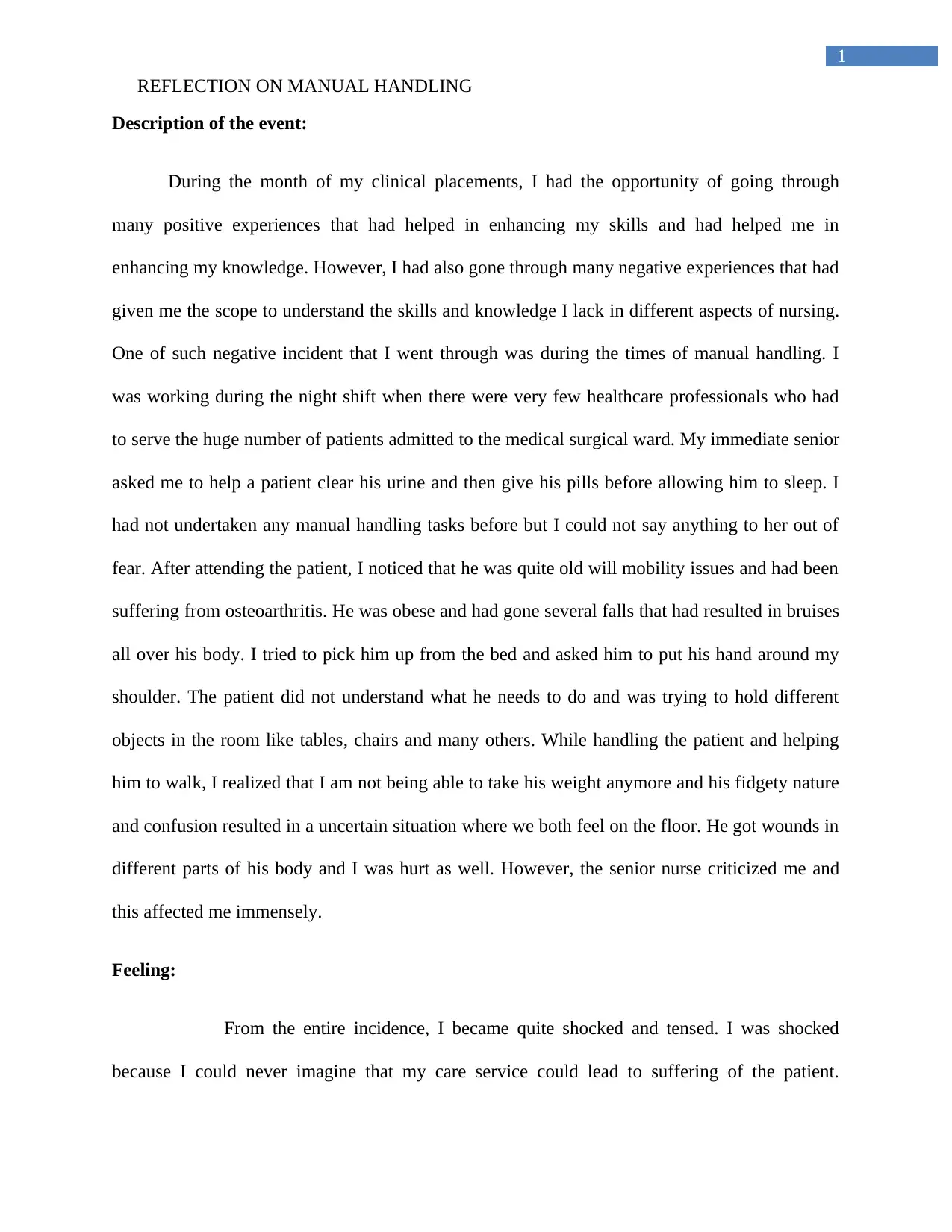
1
REFLECTION ON MANUAL HANDLING
Description of the event:
During the month of my clinical placements, I had the opportunity of going through
many positive experiences that had helped in enhancing my skills and had helped me in
enhancing my knowledge. However, I had also gone through many negative experiences that had
given me the scope to understand the skills and knowledge I lack in different aspects of nursing.
One of such negative incident that I went through was during the times of manual handling. I
was working during the night shift when there were very few healthcare professionals who had
to serve the huge number of patients admitted to the medical surgical ward. My immediate senior
asked me to help a patient clear his urine and then give his pills before allowing him to sleep. I
had not undertaken any manual handling tasks before but I could not say anything to her out of
fear. After attending the patient, I noticed that he was quite old will mobility issues and had been
suffering from osteoarthritis. He was obese and had gone several falls that had resulted in bruises
all over his body. I tried to pick him up from the bed and asked him to put his hand around my
shoulder. The patient did not understand what he needs to do and was trying to hold different
objects in the room like tables, chairs and many others. While handling the patient and helping
him to walk, I realized that I am not being able to take his weight anymore and his fidgety nature
and confusion resulted in a uncertain situation where we both feel on the floor. He got wounds in
different parts of his body and I was hurt as well. However, the senior nurse criticized me and
this affected me immensely.
Feeling:
From the entire incidence, I became quite shocked and tensed. I was shocked
because I could never imagine that my care service could lead to suffering of the patient.
REFLECTION ON MANUAL HANDLING
Description of the event:
During the month of my clinical placements, I had the opportunity of going through
many positive experiences that had helped in enhancing my skills and had helped me in
enhancing my knowledge. However, I had also gone through many negative experiences that had
given me the scope to understand the skills and knowledge I lack in different aspects of nursing.
One of such negative incident that I went through was during the times of manual handling. I
was working during the night shift when there were very few healthcare professionals who had
to serve the huge number of patients admitted to the medical surgical ward. My immediate senior
asked me to help a patient clear his urine and then give his pills before allowing him to sleep. I
had not undertaken any manual handling tasks before but I could not say anything to her out of
fear. After attending the patient, I noticed that he was quite old will mobility issues and had been
suffering from osteoarthritis. He was obese and had gone several falls that had resulted in bruises
all over his body. I tried to pick him up from the bed and asked him to put his hand around my
shoulder. The patient did not understand what he needs to do and was trying to hold different
objects in the room like tables, chairs and many others. While handling the patient and helping
him to walk, I realized that I am not being able to take his weight anymore and his fidgety nature
and confusion resulted in a uncertain situation where we both feel on the floor. He got wounds in
different parts of his body and I was hurt as well. However, the senior nurse criticized me and
this affected me immensely.
Feeling:
From the entire incidence, I became quite shocked and tensed. I was shocked
because I could never imagine that my care service could lead to suffering of the patient.
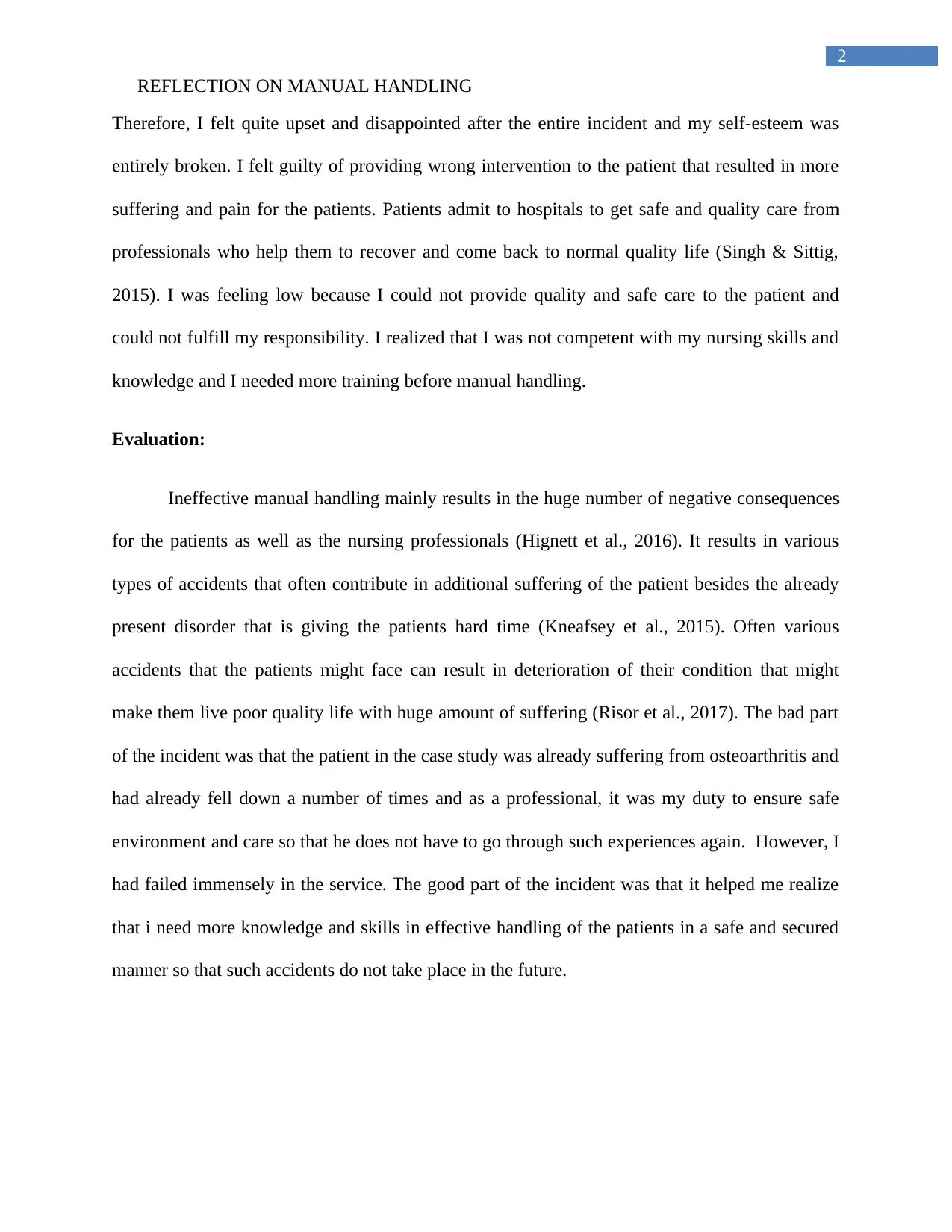
2
REFLECTION ON MANUAL HANDLING
Therefore, I felt quite upset and disappointed after the entire incident and my self-esteem was
entirely broken. I felt guilty of providing wrong intervention to the patient that resulted in more
suffering and pain for the patients. Patients admit to hospitals to get safe and quality care from
professionals who help them to recover and come back to normal quality life (Singh & Sittig,
2015). I was feeling low because I could not provide quality and safe care to the patient and
could not fulfill my responsibility. I realized that I was not competent with my nursing skills and
knowledge and I needed more training before manual handling.
Evaluation:
Ineffective manual handling mainly results in the huge number of negative consequences
for the patients as well as the nursing professionals (Hignett et al., 2016). It results in various
types of accidents that often contribute in additional suffering of the patient besides the already
present disorder that is giving the patients hard time (Kneafsey et al., 2015). Often various
accidents that the patients might face can result in deterioration of their condition that might
make them live poor quality life with huge amount of suffering (Risor et al., 2017). The bad part
of the incident was that the patient in the case study was already suffering from osteoarthritis and
had already fell down a number of times and as a professional, it was my duty to ensure safe
environment and care so that he does not have to go through such experiences again. However, I
had failed immensely in the service. The good part of the incident was that it helped me realize
that i need more knowledge and skills in effective handling of the patients in a safe and secured
manner so that such accidents do not take place in the future.
REFLECTION ON MANUAL HANDLING
Therefore, I felt quite upset and disappointed after the entire incident and my self-esteem was
entirely broken. I felt guilty of providing wrong intervention to the patient that resulted in more
suffering and pain for the patients. Patients admit to hospitals to get safe and quality care from
professionals who help them to recover and come back to normal quality life (Singh & Sittig,
2015). I was feeling low because I could not provide quality and safe care to the patient and
could not fulfill my responsibility. I realized that I was not competent with my nursing skills and
knowledge and I needed more training before manual handling.
Evaluation:
Ineffective manual handling mainly results in the huge number of negative consequences
for the patients as well as the nursing professionals (Hignett et al., 2016). It results in various
types of accidents that often contribute in additional suffering of the patient besides the already
present disorder that is giving the patients hard time (Kneafsey et al., 2015). Often various
accidents that the patients might face can result in deterioration of their condition that might
make them live poor quality life with huge amount of suffering (Risor et al., 2017). The bad part
of the incident was that the patient in the case study was already suffering from osteoarthritis and
had already fell down a number of times and as a professional, it was my duty to ensure safe
environment and care so that he does not have to go through such experiences again. However, I
had failed immensely in the service. The good part of the incident was that it helped me realize
that i need more knowledge and skills in effective handling of the patients in a safe and secured
manner so that such accidents do not take place in the future.
⊘ This is a preview!⊘
Do you want full access?
Subscribe today to unlock all pages.

Trusted by 1+ million students worldwide
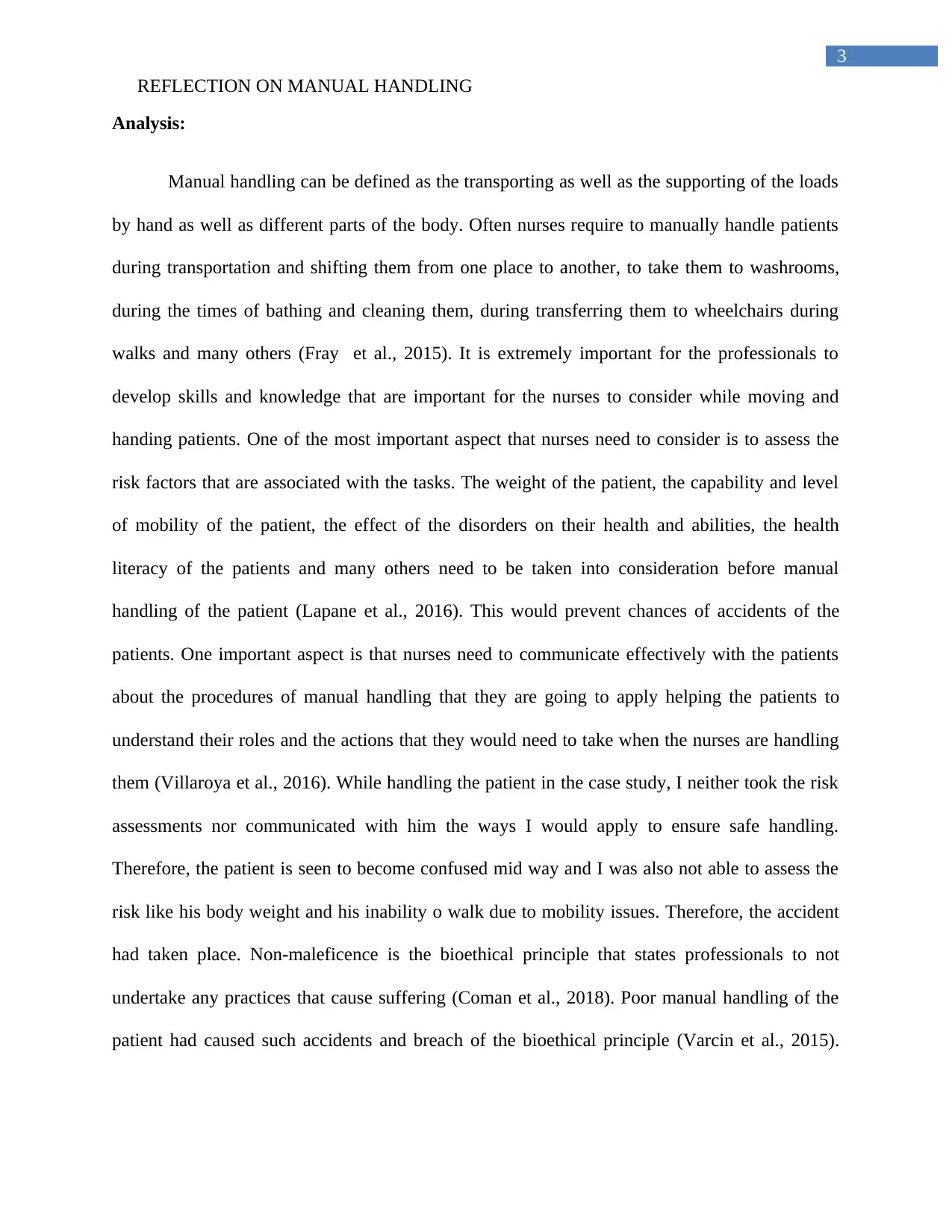
3
REFLECTION ON MANUAL HANDLING
Analysis:
Manual handling can be defined as the transporting as well as the supporting of the loads
by hand as well as different parts of the body. Often nurses require to manually handle patients
during transportation and shifting them from one place to another, to take them to washrooms,
during the times of bathing and cleaning them, during transferring them to wheelchairs during
walks and many others (Fray et al., 2015). It is extremely important for the professionals to
develop skills and knowledge that are important for the nurses to consider while moving and
handing patients. One of the most important aspect that nurses need to consider is to assess the
risk factors that are associated with the tasks. The weight of the patient, the capability and level
of mobility of the patient, the effect of the disorders on their health and abilities, the health
literacy of the patients and many others need to be taken into consideration before manual
handling of the patient (Lapane et al., 2016). This would prevent chances of accidents of the
patients. One important aspect is that nurses need to communicate effectively with the patients
about the procedures of manual handling that they are going to apply helping the patients to
understand their roles and the actions that they would need to take when the nurses are handling
them (Villaroya et al., 2016). While handling the patient in the case study, I neither took the risk
assessments nor communicated with him the ways I would apply to ensure safe handling.
Therefore, the patient is seen to become confused mid way and I was also not able to assess the
risk like his body weight and his inability o walk due to mobility issues. Therefore, the accident
had taken place. Non-maleficence is the bioethical principle that states professionals to not
undertake any practices that cause suffering (Coman et al., 2018). Poor manual handling of the
patient had caused such accidents and breach of the bioethical principle (Varcin et al., 2015).
REFLECTION ON MANUAL HANDLING
Analysis:
Manual handling can be defined as the transporting as well as the supporting of the loads
by hand as well as different parts of the body. Often nurses require to manually handle patients
during transportation and shifting them from one place to another, to take them to washrooms,
during the times of bathing and cleaning them, during transferring them to wheelchairs during
walks and many others (Fray et al., 2015). It is extremely important for the professionals to
develop skills and knowledge that are important for the nurses to consider while moving and
handing patients. One of the most important aspect that nurses need to consider is to assess the
risk factors that are associated with the tasks. The weight of the patient, the capability and level
of mobility of the patient, the effect of the disorders on their health and abilities, the health
literacy of the patients and many others need to be taken into consideration before manual
handling of the patient (Lapane et al., 2016). This would prevent chances of accidents of the
patients. One important aspect is that nurses need to communicate effectively with the patients
about the procedures of manual handling that they are going to apply helping the patients to
understand their roles and the actions that they would need to take when the nurses are handling
them (Villaroya et al., 2016). While handling the patient in the case study, I neither took the risk
assessments nor communicated with him the ways I would apply to ensure safe handling.
Therefore, the patient is seen to become confused mid way and I was also not able to assess the
risk like his body weight and his inability o walk due to mobility issues. Therefore, the accident
had taken place. Non-maleficence is the bioethical principle that states professionals to not
undertake any practices that cause suffering (Coman et al., 2018). Poor manual handling of the
patient had caused such accidents and breach of the bioethical principle (Varcin et al., 2015).
Paraphrase This Document
Need a fresh take? Get an instant paraphrase of this document with our AI Paraphraser
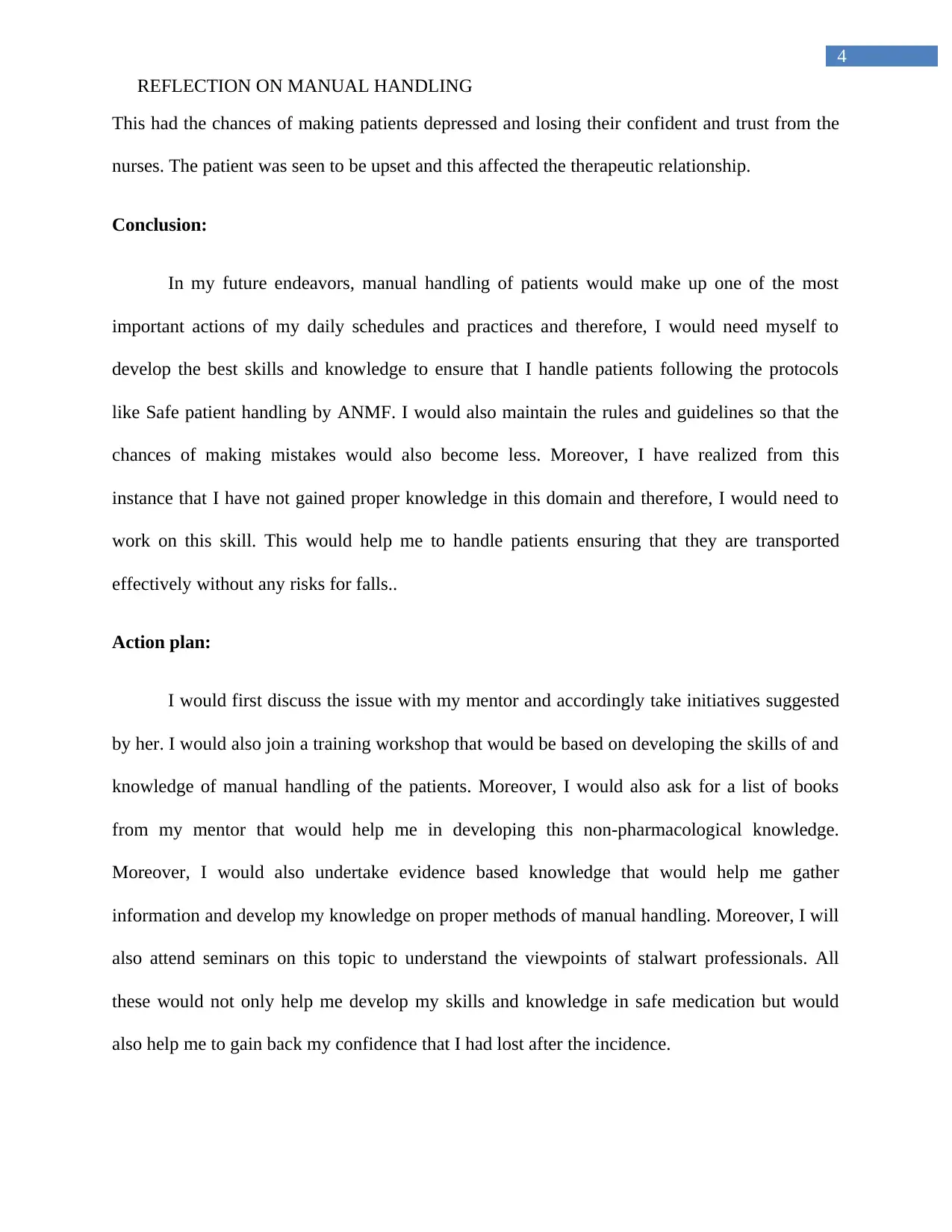
4
REFLECTION ON MANUAL HANDLING
This had the chances of making patients depressed and losing their confident and trust from the
nurses. The patient was seen to be upset and this affected the therapeutic relationship.
Conclusion:
In my future endeavors, manual handling of patients would make up one of the most
important actions of my daily schedules and practices and therefore, I would need myself to
develop the best skills and knowledge to ensure that I handle patients following the protocols
like Safe patient handling by ANMF. I would also maintain the rules and guidelines so that the
chances of making mistakes would also become less. Moreover, I have realized from this
instance that I have not gained proper knowledge in this domain and therefore, I would need to
work on this skill. This would help me to handle patients ensuring that they are transported
effectively without any risks for falls..
Action plan:
I would first discuss the issue with my mentor and accordingly take initiatives suggested
by her. I would also join a training workshop that would be based on developing the skills of and
knowledge of manual handling of the patients. Moreover, I would also ask for a list of books
from my mentor that would help me in developing this non-pharmacological knowledge.
Moreover, I would also undertake evidence based knowledge that would help me gather
information and develop my knowledge on proper methods of manual handling. Moreover, I will
also attend seminars on this topic to understand the viewpoints of stalwart professionals. All
these would not only help me develop my skills and knowledge in safe medication but would
also help me to gain back my confidence that I had lost after the incidence.
REFLECTION ON MANUAL HANDLING
This had the chances of making patients depressed and losing their confident and trust from the
nurses. The patient was seen to be upset and this affected the therapeutic relationship.
Conclusion:
In my future endeavors, manual handling of patients would make up one of the most
important actions of my daily schedules and practices and therefore, I would need myself to
develop the best skills and knowledge to ensure that I handle patients following the protocols
like Safe patient handling by ANMF. I would also maintain the rules and guidelines so that the
chances of making mistakes would also become less. Moreover, I have realized from this
instance that I have not gained proper knowledge in this domain and therefore, I would need to
work on this skill. This would help me to handle patients ensuring that they are transported
effectively without any risks for falls..
Action plan:
I would first discuss the issue with my mentor and accordingly take initiatives suggested
by her. I would also join a training workshop that would be based on developing the skills of and
knowledge of manual handling of the patients. Moreover, I would also ask for a list of books
from my mentor that would help me in developing this non-pharmacological knowledge.
Moreover, I would also undertake evidence based knowledge that would help me gather
information and develop my knowledge on proper methods of manual handling. Moreover, I will
also attend seminars on this topic to understand the viewpoints of stalwart professionals. All
these would not only help me develop my skills and knowledge in safe medication but would
also help me to gain back my confidence that I had lost after the incidence.
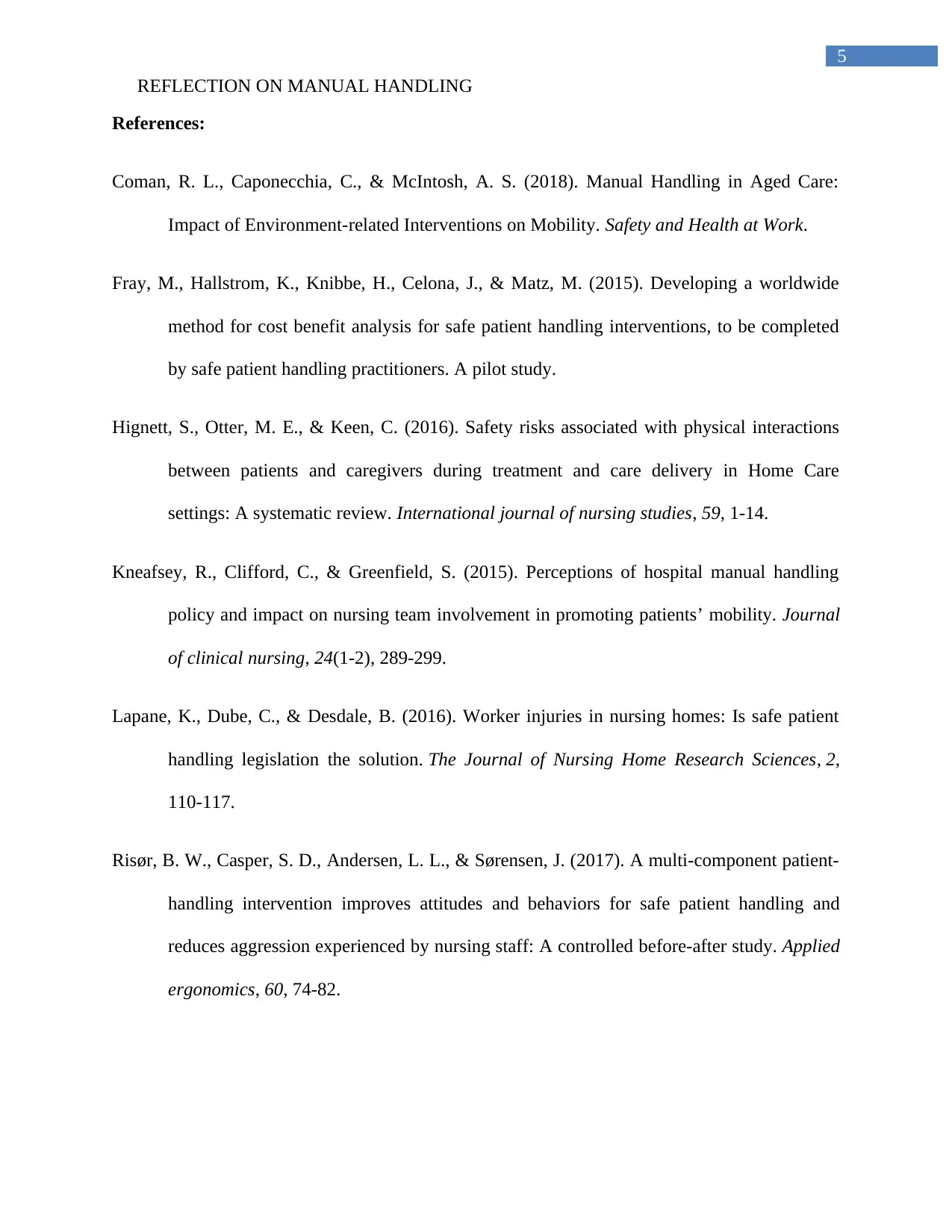
5
REFLECTION ON MANUAL HANDLING
References:
Coman, R. L., Caponecchia, C., & McIntosh, A. S. (2018). Manual Handling in Aged Care:
Impact of Environment-related Interventions on Mobility. Safety and Health at Work.
Fray, M., Hallstrom, K., Knibbe, H., Celona, J., & Matz, M. (2015). Developing a worldwide
method for cost benefit analysis for safe patient handling interventions, to be completed
by safe patient handling practitioners. A pilot study.
Hignett, S., Otter, M. E., & Keen, C. (2016). Safety risks associated with physical interactions
between patients and caregivers during treatment and care delivery in Home Care
settings: A systematic review. International journal of nursing studies, 59, 1-14.
Kneafsey, R., Clifford, C., & Greenfield, S. (2015). Perceptions of hospital manual handling
policy and impact on nursing team involvement in promoting patients’ mobility. Journal
of clinical nursing, 24(1-2), 289-299.
Lapane, K., Dube, C., & Desdale, B. (2016). Worker injuries in nursing homes: Is safe patient
handling legislation the solution. The Journal of Nursing Home Research Sciences, 2,
110-117.
Risør, B. W., Casper, S. D., Andersen, L. L., & Sørensen, J. (2017). A multi-component patient-
handling intervention improves attitudes and behaviors for safe patient handling and
reduces aggression experienced by nursing staff: A controlled before-after study. Applied
ergonomics, 60, 74-82.
REFLECTION ON MANUAL HANDLING
References:
Coman, R. L., Caponecchia, C., & McIntosh, A. S. (2018). Manual Handling in Aged Care:
Impact of Environment-related Interventions on Mobility. Safety and Health at Work.
Fray, M., Hallstrom, K., Knibbe, H., Celona, J., & Matz, M. (2015). Developing a worldwide
method for cost benefit analysis for safe patient handling interventions, to be completed
by safe patient handling practitioners. A pilot study.
Hignett, S., Otter, M. E., & Keen, C. (2016). Safety risks associated with physical interactions
between patients and caregivers during treatment and care delivery in Home Care
settings: A systematic review. International journal of nursing studies, 59, 1-14.
Kneafsey, R., Clifford, C., & Greenfield, S. (2015). Perceptions of hospital manual handling
policy and impact on nursing team involvement in promoting patients’ mobility. Journal
of clinical nursing, 24(1-2), 289-299.
Lapane, K., Dube, C., & Desdale, B. (2016). Worker injuries in nursing homes: Is safe patient
handling legislation the solution. The Journal of Nursing Home Research Sciences, 2,
110-117.
Risør, B. W., Casper, S. D., Andersen, L. L., & Sørensen, J. (2017). A multi-component patient-
handling intervention improves attitudes and behaviors for safe patient handling and
reduces aggression experienced by nursing staff: A controlled before-after study. Applied
ergonomics, 60, 74-82.
⊘ This is a preview!⊘
Do you want full access?
Subscribe today to unlock all pages.

Trusted by 1+ million students worldwide
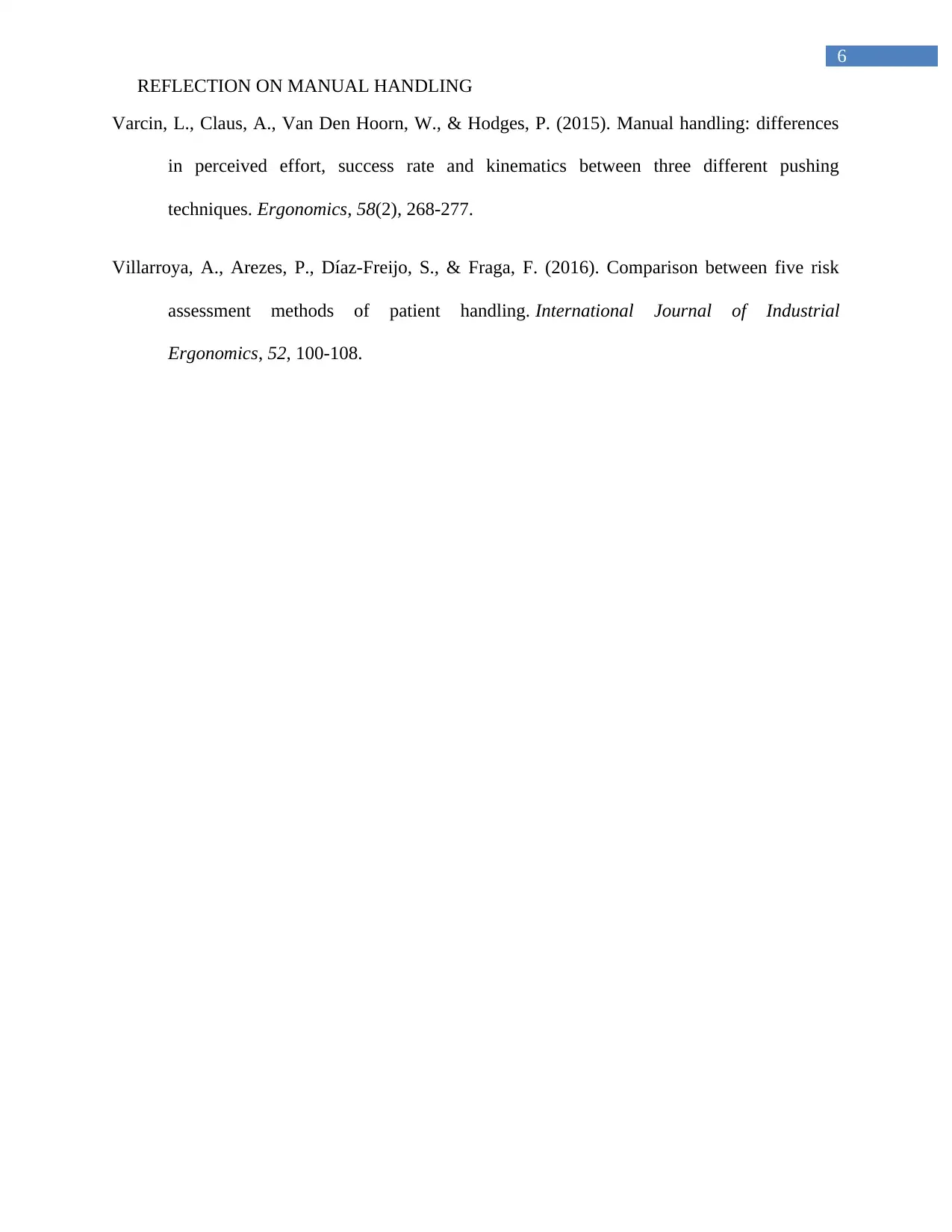
6
REFLECTION ON MANUAL HANDLING
Varcin, L., Claus, A., Van Den Hoorn, W., & Hodges, P. (2015). Manual handling: differences
in perceived effort, success rate and kinematics between three different pushing
techniques. Ergonomics, 58(2), 268-277.
Villarroya, A., Arezes, P., Díaz-Freijo, S., & Fraga, F. (2016). Comparison between five risk
assessment methods of patient handling. International Journal of Industrial
Ergonomics, 52, 100-108.
REFLECTION ON MANUAL HANDLING
Varcin, L., Claus, A., Van Den Hoorn, W., & Hodges, P. (2015). Manual handling: differences
in perceived effort, success rate and kinematics between three different pushing
techniques. Ergonomics, 58(2), 268-277.
Villarroya, A., Arezes, P., Díaz-Freijo, S., & Fraga, F. (2016). Comparison between five risk
assessment methods of patient handling. International Journal of Industrial
Ergonomics, 52, 100-108.
1 out of 7
Related Documents
Your All-in-One AI-Powered Toolkit for Academic Success.
+13062052269
info@desklib.com
Available 24*7 on WhatsApp / Email
![[object Object]](/_next/static/media/star-bottom.7253800d.svg)
Unlock your academic potential
Copyright © 2020–2025 A2Z Services. All Rights Reserved. Developed and managed by ZUCOL.




